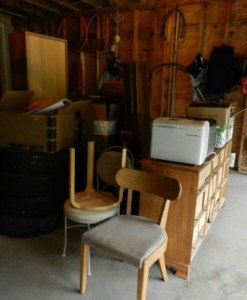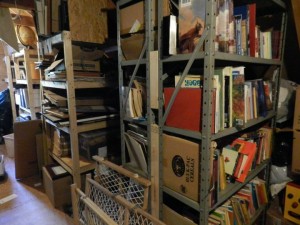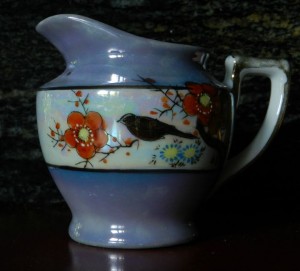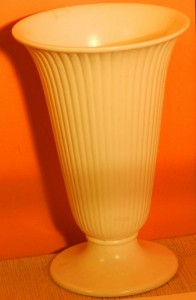
Last year, my dad downsized from an independent two-bedroom apartment to an assisted two-room suite. This move involved shedding a great deal of Stuff: ancient mattresses went straight to the dump, clothes to a charity thrift store, and books to the library sale. The furniture, artwork and bric-a-brac presented a more difficult challenge, especially when my brothers, nieces, cousins and children all turned down Dad’s Better Stuff.
These were treasures he didn’t want to give away but could no longer keep; as the dutiful daughter, I took them. Months later, my three grown children all decided to move far away (to California, Brooklyn and The Republic of Georgia). They gave away everything save a few household treasures, which are now stored at my house, where I have both a large attic and dry basement. Unfortunately, these are now both filled.

We live by the rule, If it ain’t broke, don’t fix it; if it is broke, don’t throw it out, so our basement was already well-furnished with crumpled chairs and the attic stocked with fabric – things that may come in handy Some Day, even though Some Day never arrives.
While it’s just two of us living at home, it’s entirely inaccurate to call our house an empty nest, and I’m determined to clean up, clean out, unclutter and tidy up.
I’m not alone.
Evidently, even people who live alone or without barns and basements have issues with Stuff, which helps explain Marie Kondo’s best-selling book, The Life-Changing Magic of Tidying Up. She’s a professional organizer who recommends piling all your books in the living room and throwing away all that don’t give you joy.
I’d start with hers.
If I attempted this method, I’m sure I would have books on the floor forever – during which time I’d fill the empty bookcases with new-to-me titles purchased at the library sale. I also take issue with using a joy quotient as the single measure of an item’s worthiness. How can I quantify the amount of joy derived from books I haven’t yet read?
But the books are the least of the clutter, which is mostly tied up in ceramic figures the kids made in grade school, my grandmother’s china, and my mother’s chafing dish. Joy and utility aren’t really the issue: Sentiment is.

I own a lusterware creamer that I believe is the single remaining piece of one of my paternal grandmother’s four sets of china. (She kept a kosher home, with separate dishes for milk and meat meals, and special sets just for Passover.) I never knew this grandmother, who died eleven years before I was born but for whom I was named. This small pitcher contains a great deal of sentiment for a woman about whom I know only from a photograph and second-hand stories.
I knew and adored my maternal grandmother, so I hold on to the needlepoint chair covers she stitched. Whenever I come across them in the attic while searching for Something Else, I’m reminded that Some Day I want to upholster two chairs with these labors of love. The chairs, of course, are in the basement awaiting repair. Some Day.

Meanwhile, there were things of my parents that Dad didn’t want – and neither do I, like Lenox and Wedgewood vases, so I inventoried them with photographs and sent them off to be auctioned.
If I had fantasies of gaining riches for my pains, the auctioneer quickly dispelled them. There’s currently a glut on the market of mid-century decorative objets of the middle class. Nevertheless, I persisted, for three reasons.
First, I figured if someone liked them enough to pay money, these things would be treasured and even bring joy into their new owner’s home.
Second, sending stuff to auction got it out of my house. Less clutter.
Finally, it was while photographing each item for the inventory that evoked memories that are mine to keep. I dispatched Mom’s Majorcan cake plate, but retain the flavor of the pastries she served on it at the end of special occasion celebrations.
I still haven’t unpacked my dad’s artwork, but I’ve upgraded my furnishings, replacing box springs on the floor with cherry bedsteads and nightstands that match. We now tuck our polypropylene long underwear into the dressers where my parents stored their Duofold. And the child moving to Brooklyn is taking the dining room set, which none of us could bear to give away.
It’s unlikely that I will ever place every item of clothing in the house on the floor, “treat my socks and stocking with respect” or resist downgrading stained clothing to gardening attire, all of which Kondo suggests. But I have moved twenty-five file boxes from the attic to the garage, where they await the itinerant shredder. While destroying thirty-year-old utility bills from when I lived in New York may make historians shudder, doing so is a step toward emptying my cluttered nest.
Deborah Lee Luskin has a life-long obsession with The Middle Ages: Into the Wilderness is her award-winning love story between people in their mid-sixties. This piece first appeared in The Rutland Herald, July 22, 2015.
It’s difficult when everyone else fills up your “empty” nest. The Lusterware creamer is a pretty piece. Definitely a keeper. I’m starting to sort and get rid of some things, too. Every little bit helps.
“Every little bit helps.” Yes! Like so many things in life: one step at a time, not drastic (and usually unsustainable) makeovers.
Thanks for your insight – and good luck.
Our youngest child has now left home and though I was not looking forward to it, it is rather nice just being a couple again after 30 years of having a house full of children and their friends. However, I find I’m sorting out the clutter almost to the point of obsession…….so much Stuff has accumulated over the years and I feel that clearing it out will free me to look at new things. But it’s not easy, so yes, step by step. Thank you for your article. I too find it hard to get rid of books, which is odd, because they’re one of the easiest things to replace.
Thanks for your comment – and good luck with your Stuff! As for books, though: I’m wondering how much longer paper and ink ones will be easy to replace, and if digital immigrants like ourselves will ever really believe that an ebook is just the same. . .All best.